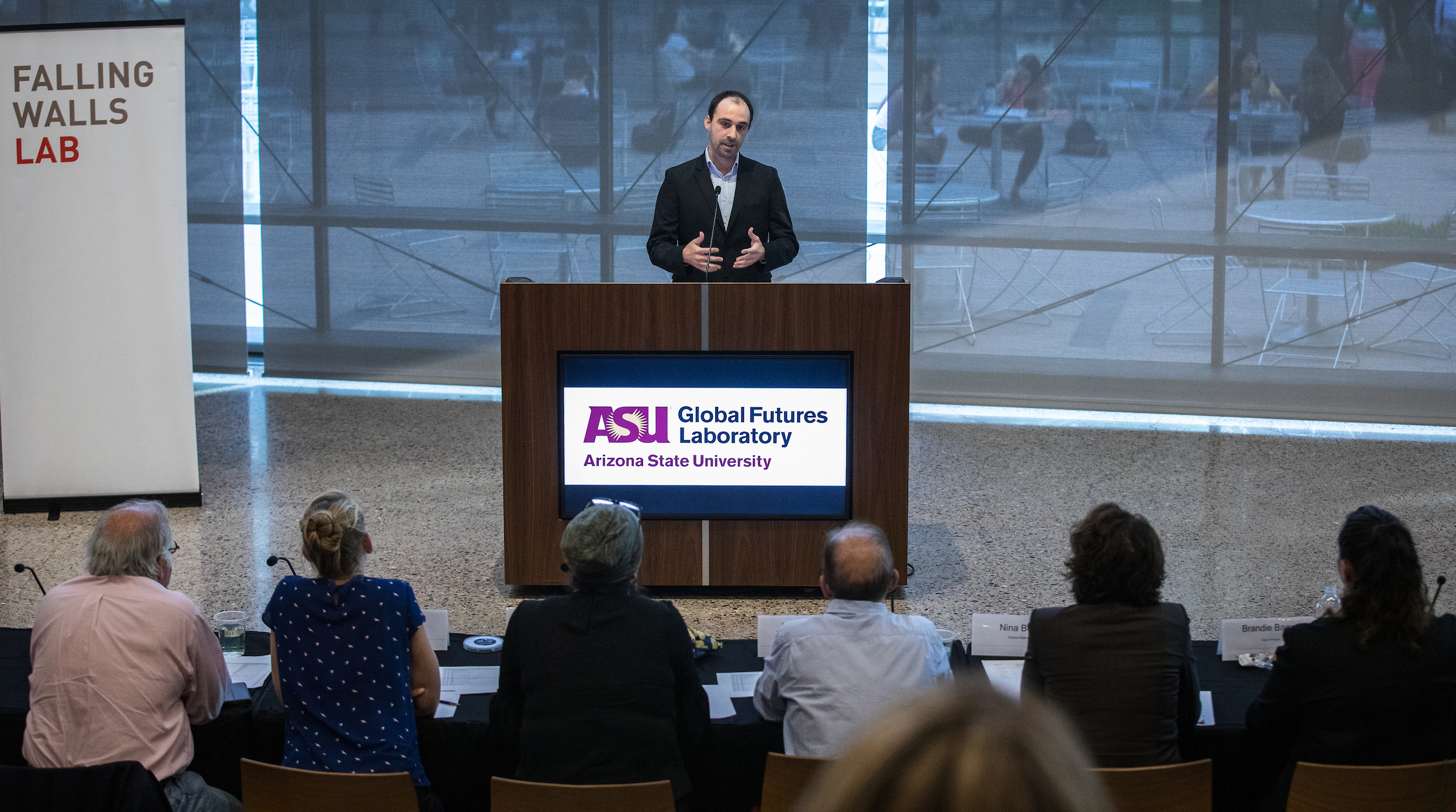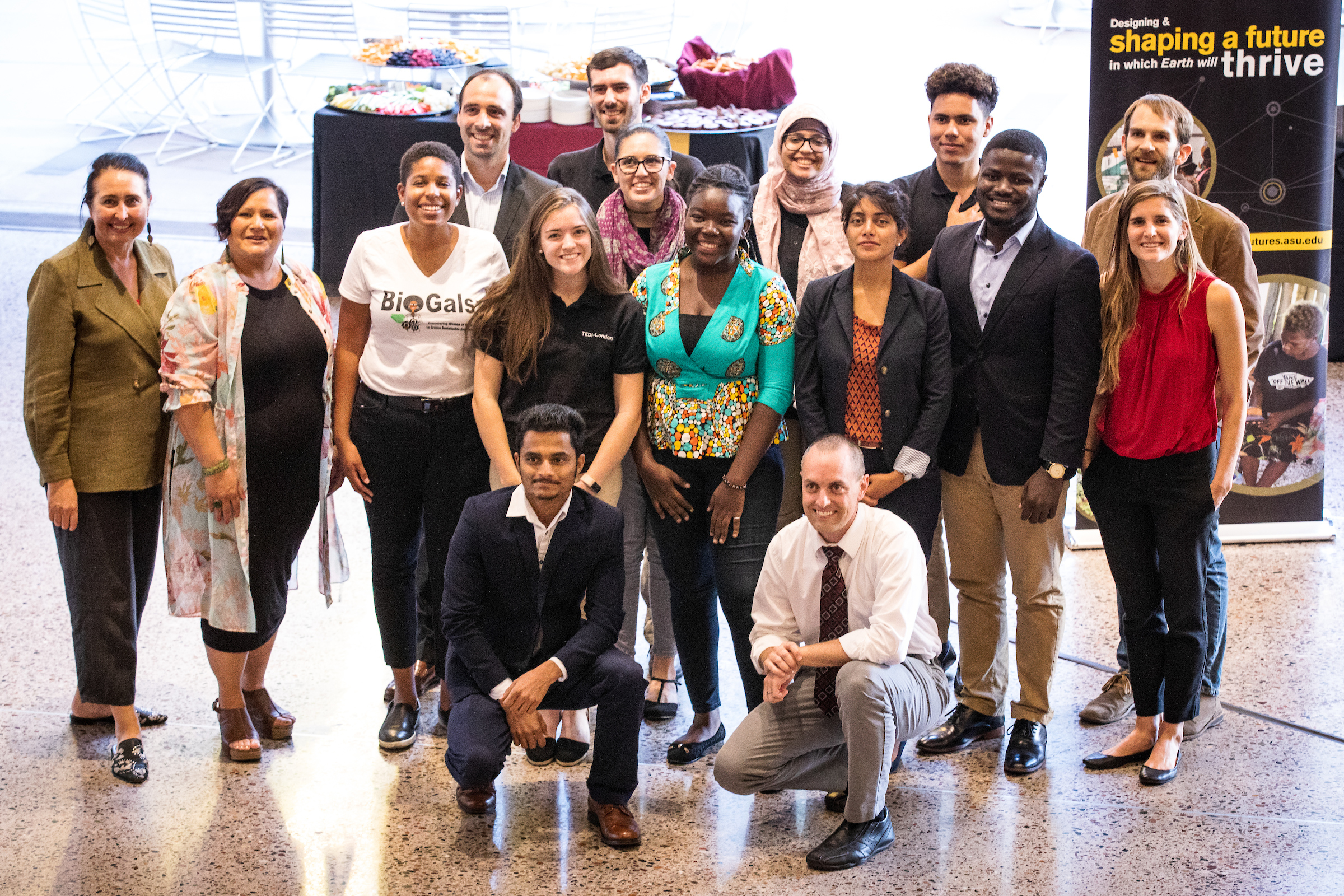A PhD student at Arizona State University who is finding a way to clean water with light will get the chance to present her research on a global stage after she won the Falling Walls Lab event on Friday at the Downtown Phoenix campus.
Mariana Lanzarini-Lopes (pictured above), who is working on her PhD in environmental engineering, was one of 12 research competitors at the pitch event and won a trip to Berlin for the Falling Walls Lab finale next month.
The competition, sponsored by the Global Futures Laboratory at ASU, showcased research in technology, education and the arts. Falling Walls Labs have been held around the world every year since 2011, and this was the first one in Arizona, with jurors from all three public universities and Maricopa Community Colleges. The research showcases are part of the Falling Walls Foundation, an international platform for science, business, politics, the arts and society that was created in 2009 to mark the 20th anniversary of the fall of the Berlin Wall. This year’s lab finale will be held Nov. 9, the 30th anniversary.
In her pitch, Lanzarini-Lopes told the judges that 2 billion people around the world drink contaminated water and 500,000 people die from it every year. LED light has been known to be a disinfectant, but the problem has been deploying it efficiently, because the lights must be close to the microbes to kill them.
“If you look at current water treatment systems, they use bulky lamps that are not energy-efficient and contain mercury and are not available in developing countries,” she said.
She’s working on a way to use flexible optical fibers woven into a fabric to disinfect water at treatment plants and in pipes.
Lanzarini-Lopes works in the NEWT lab, the Nanosystems Engineering Research Center for Nanotechnology-Enabled Water Treatment, run by Paul Westerhoff, and has received funding from NASA to investigate how the system could work in space.
“We really brainstormed and figured out that we knew a way to go forward, even though there were a lot of technological challenges,” said Lanzarini-Lopes, who previously did research at the Lawrence Livermore National Laboratory in California.
She said she’s excited to be one of about 100 presenters from around the world at the finale event in Berlin next month. After defending her dissertation early next year, she’s considering whether to spend time in the business world in order to spin off her work into a company. But her heart is in academia.
“I love teaching. I taught an intro to engineering class at ASU, and now I teach an intro to biology class at the prison in Florence and I love that,” she said. “I’m mentoring a lot of students in the lab, which I really enjoy. I’d love to have to my own lab and take my research in the direction I want to go.”
Pablo Coll won second place at the Falling Walls Lab for his presentation about breaking the wall of the silicon empire by producing a wafer with sound waves. Photo by Charlie Leight/ASU Now
The second-place winner in the competition was Pablo Coll, a PhD student in materials science and engineering. He described his work on “sonic wafering,” a method using sound waves to more precisely cut silicon wafers for the technology industry. Coll, co-founder of the company Crystal Sonic, told the judges that traditional laser cutting of wafers produces a lot of waste and that his method is faster and more accurate. Crystal Sonic has already received thousands of dollars in funding from the Department of Energy and the National Science Foundation, as well as the Edson Student Entrepreneur Initiative at ASU.
The third-place winner was Andrew Bernier, a teacher and postdoctoral research fellow in the Rob and Melani Walton Sustainability Solutions Service at ASU, who invented a platform for teachers to evaluate students. Instead of assigning one grade per assignment, the new kind of digital gradebook would allow teachers to see how students are making connections between key concepts, and where they need more support. This could lead to deeper, project-based teaching.
Eleven of the competitors were from ASU and one, Michael Larson, was from the University of Arizona. Larson is creating a new kind of biopsy needle that can harvest a larger amount of tumor tissue than conventional needles, potentially reducing the need for repeat biopsies. A greater sample of tumor tissue also allows for more personalized cancer therapies.
Before the researchers presented their work, Volker Benkert, an assistant professor of history at ASU, described the extraordinary events that led up to the fall of the Berlin Wall and the reunification of Germany.
“Thousands of people had gathered at the wall and the border guards have to make a choice. They have standing orders to fire at people who approach the wall. Will they shoot?” he said. “In the end, they decided, ‘OK, we’ll open the border.’
“These were ordinary people who stepped courageously out of their homes into the street, where they were vulnerable to arrest.”
Yet many obstacles to freedom remain, he said.
“There are thousands of walls to be torn down. This is a project for many generations.”
Group photo of the participants at the Falling Walls Lab Arizona pitch-style forum. Photo by Charlie Leight/ASU Now
Top photo: Mariana Lanzarini-Lopes talks about breaking the wall of waterborne diseases using UVC glowing optical fibers to purify water at the Beus Center for Law and Society on Oct. 4. Lanzarini-Lopes won first place at the Falling Walls Lab Arizona pitch-style forum that highlights innovative work in individual labs at the state universities. Photo by Charlie Leight/ASU Now
More Science and technology

ASU-led space telescope is ready to fly
The Star Planet Activity Research CubeSat, or SPARCS, a small space telescope that will monitor the flares and sunspot activity of low-mass stars, has now passed its pre-shipment review by NASA.…

ASU at the heart of the state's revitalized microelectronics industry
A stronger local economy, more reliable technology, and a future where our computers and devices do the impossible: that’s the transformation ASU is driving through its microelectronics research…

Breakthrough copper alloy achieves unprecedented high-temperature performance
A team of researchers from Arizona State University, the U.S. Army Research Laboratory, Lehigh University and Louisiana State University has developed a groundbreaking high-temperature copper alloy…




